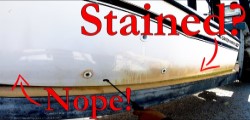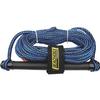For smaller boats that don't have the luxury of davits or deck space to store a dinghy, some boaters have little choice but to tow their tender behind while underway. This tow line is refered to as a "painter". There are three drawbacks of doing so, each of which should be considered before towing:
- Increased drag while underway
- Possibility of flipping the dinghy
- Complications in docking
- Dinghy running into your stern during rough conditions
- Painter line wrapping itself around the propeller
- Losing the dinghy completely due to improperly tied or damaged painter line
Dinghy Attachment Point
The last point of the list above is vital to remember - and most dinghies are lost because the attachment point on its bow fails. If you find an abandoned dinghy on a beach, quite likely this eyelet will be damaged! Be sure this attachment point is extremely strong. Most small boats use inflatable dinghies rather than rigid hulls; unfortunately, inflatable dinghies tend to create more drag as their round pontoons and concave bottoms can create more suction on the water - and to make matters worse, their attachment points are often weak due to their construction from lighter materials.
If possible, reinforce its material. Also, rather than tying the dinghy to the end of the painter, consider leaving a few feet and tying a back-up knot on a secondary point of the dinghy; it might be helpful to tie it somewhere on the forward corner of the dinghy, so if the main attachment point fails, the dinghy will begin to travel in a conspicuous manner, alerting you to the fact the main attachment point failed.
Stern Attachment Point
Luckily, you boat probably has a strong cleat on the stern. Consider constructing a bridle with two lines attached to the boat and connected to the single line a few feet astern so that the dinghy follows directly behind the boat and not off to one side. No matter where you attach your dinghy towline to the boat, make sure it can be quickly thrown off in an emergency and make sure the tow line is at least 100 feet long so you can adjust it for varying conditions.
While underway in heavy following seas, it never hurts to keep it as far as 100 feet away to prevent it from surfing a wave into your stern!
The Painter
Shock absorbtion is an excellent feature to find in a painter. Floating line is also helpful to prevent propeller foulings. If your line sinks, consider attaching floats to the line.
How Long?
There is certainly no perfect length, but generally speaking, while underway there is no "maximum length" - yet the more line dragging in the water, the more drag it will generate. There is of course, a definite "minimum length" - if the painter is too short, the dinghy will be pulled UP to your stern cleat. This will cause the stern of your dinghy to dig into the water, causing significant drag.
Ideally, you can find an ideal length for your painter so that the dinghy can continually surf down your stern wave - not the wave right behind your boat but the next (see the diagram below). However, the length of your stern wave will change as your speed increases or decreases, so be sure to periodically adjust the length of your painter.

The best way to determine where to place your dinghy is to simply hold the line in your hand. Experiment with different lengths, and find which length pulls on your hand with the least resistance. If the dinghy wants to pull you off the back of the boat, it probably isn't going to help your forward sailing speed!
Making it Easier
Weight equals drag. To reduce drag, remove as much weight as possible from the dinghy by removing the outboard motor, oars, or anything else that would contribute to increased drag.












